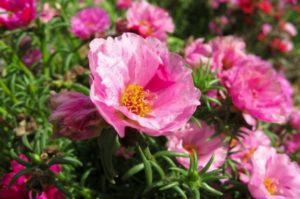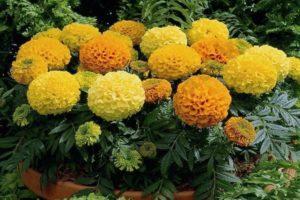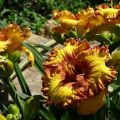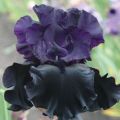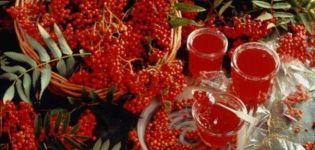30 varieties and species of daylilies blooming all summer with descriptions and characteristics
Daylilies are considered one of the most elegant ornamental crops. Herbaceous plants have powerful roots, thanks to which flower beds are formed from dense dark green basal leaves. Strong flower stalks topped with buds rise above them. During flowering, daylilies of most varieties bloom from 20 to 50 flowers. In terms of the variety of the shape of leaves, buds, the color of the petals, the height of the bush, no garden plant can match them.
Varieties of daylilies
In the garden landscape, wild species and their hybrids are used. The quality of the variety is determined by positional branching: the more side branches and the presence of a V-divergence at the top, the more abundant and longer the flowering of the daylily will be.
In terms of the variety of color of petals, not a single flower can compete with beautiful flowers.
The palette of shades reaches several hundred.
Basic tones of buds:
- yellow;
- red;
- Violet;
- pink;
- melon.
All colors are shades of overflow and mixing of colors. For example, for yellow, these are shades ranging from lemon to orange. The combination of different saturations of pink-yellow tones gives apricot and peach color.

The buds are monochromatic, one-color, two-tone, two-color, polychrome. The stamens and pistil may not match the color of the sepals and petals. An addition to the color scheme of daylilies can be the "spray" effect.
The petals shine in the sunlight with silver, diamond, gold sparks.
Natural species
The basis for hybridization was the usual natural daylilies: powerful, unpretentious plants with spectacular orange and yellow flowers. 4 varieties are especially popular with gardeners.
Dumortier
The homeland of the daylily is the Japanese islands, the Korean Peninsula, and the central part of China. The flower arrows rise up to 0.7 meters. The flowers are simple, yellow-orange, up to 50 millimeters in diameter.
Orange
The tall peduncle is crowned with orange-red odorless buds.Dark green foliage covers the root zone within a radius of 30 centimeters. The plant is gaining color by early July.

Lemon yellow
Daylily with soft, wide petals grows in China. The height of the bush is up to 120 centimeters. The flowering period is the end of July.
Yellow brown
Brown-yellow medium-sized flowers adorn clumps in sunny glades or in partial shade of trees. The length of the flower stems reaches 1 meter.
Hybrid garden varieties
The number of hybrids exceeds 60 thousand. The varietal variety of daylilies is explained by scientific advances in the middle of the 20th century. Breeders were able to learn how to double the number of chromosomes in a plant: from 22 to 44.
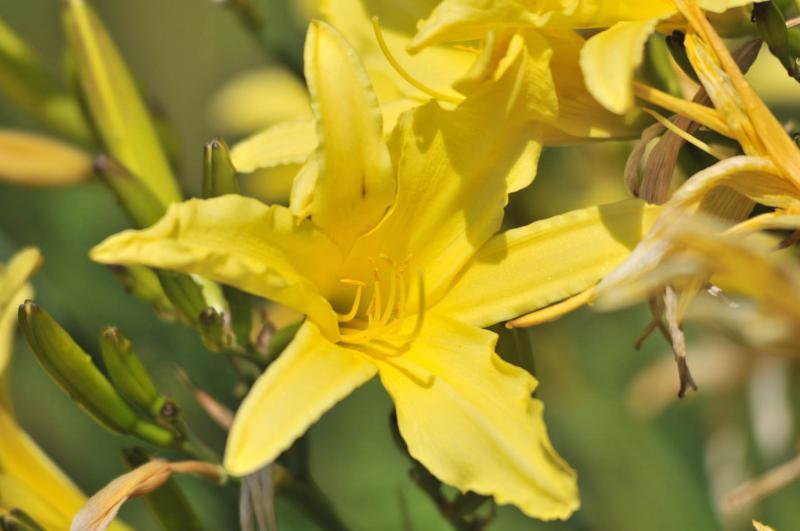
The advent of tetraploids (TET), daylilies with 44 gene structures, created unlimited conditions for the development of new varieties.
Differences between TET and diploids (with 22 genes):
- the largest flower;
- bright color;
- the strength of the stems.
TET daylilies can bloom 2 times per season in warm weather in late summer and early autumn. The interval after the main growing season is up to 2-3 weeks, after which a new arrow begins to grow. The advantages of DIP are the sophistication of the flower shapes.
The classification of plants, which determines the decorativeness of varieties, concerns:
- forms;
- bud size;
- the height of the flower arrows;
- presence of aroma.
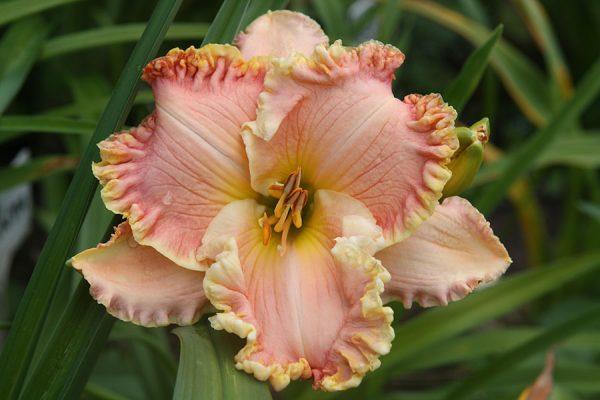
For example, by flower size, daylilies are grouped into 3 categories:
- up to 75 millimeters - mini;
- 75-115 mm - small;
- from 115 millimeters - large.
The shape of the flower is determined by the length, width of the petals, and their relative position. The number of flowers with the declared shape must exceed 50% of all buds on the daylily bush.
Double
Daylilies, in the name of which the word "double" is present, have two or three sepals. According to the classification, this is a simple flower. Each sepal has 3 petals. An open flower, depending on the projection of the gaze, can appear round, triangular, tubular, in the form of a star.
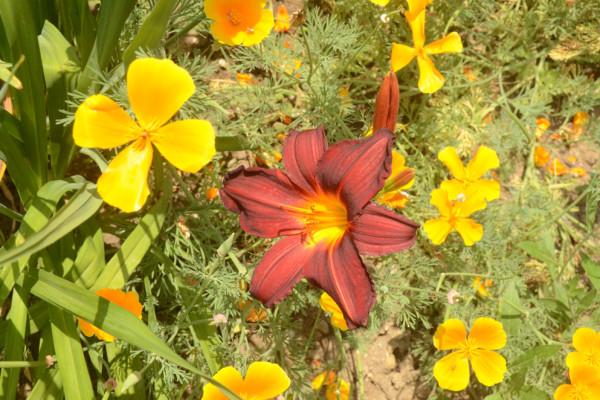
Spiders (spider-like)
In daylilies with arachnid petals, the ratio between the length and width of the petal is at least 4: 1. When leaving the neck, they do not come into contact with each other. Spiders are large-flowered daylilies.
Exclusive
Hybridizers bred plants in which the petals are twisted, cascading down, like a shoulder blade.
Polymers
The number of petals and sepals exceeds the number of stamens from which additional petals can emerge.

Multimorphs
Daylilies in which it was possible to combine two or more varieties, for example, terry spider.
Fragrant
By their ability to aromatize the air, daylilies are subdivided into odorless, aromatic and highly aromatic.
White
With all the variety of color of petals, daylilies do not have varieties of pure white color, as well as blue.
White krasodnevy have shades of yellow, melon, orange, pink.
Dwarf and undersized
According to the height of the flower arrows, lily varieties are divided (meter):
- on dwarf ones - up to 0.3;
- undersized - up to 0.6;
- medium-sized - up to 0.9;
- tall - over 0.9.
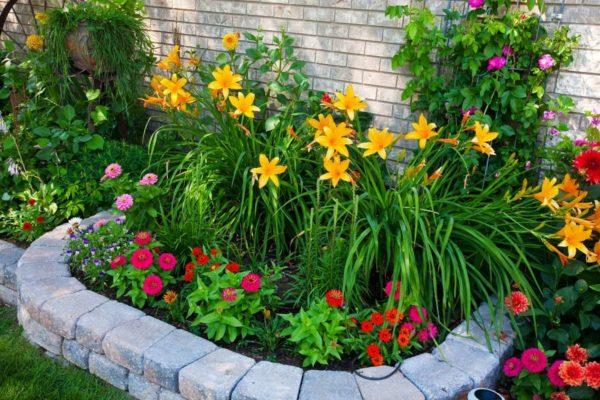
Small sizes have nothing to do with the size of flowers. Low clumps can be covered with large buds. Such varieties are used to create alpine slides in landscape design or are grown in flowerpots.
Terry
In double daylilies, part of the stamens is reborn into petals, which gives a multilevel bud. Such a flower looks like a peony or two flowers in one.
Most popular varieties
The demand for daylilies among gardeners depends on varietal characteristics:
- period and duration of flowering;
- the appearance of the buds;
- peduncle height;
- resistance to low temperatures.

Breeders are working to ensure that every flower lover can choose a plant to his taste.
Lacy Doily
On the stems from half a meter to 0.8 meters, on July 1-5, pale pink double flowers with a yellow eye appear. The plant cannot withstand cold winters.
Longfields Pearl
The buds open in the first week of August. At the neck there is yellowness with greenness, at the spatulate petals - cream color with yellowness. The span of the petals is 100 millimeters.
Bonanza
A variety close to wild-growing species, resistant to low temperatures and pests. Blooms by the second decade of July. The petals open up to 100 millimeters, shining yellow, with a cherry powder over the eye.
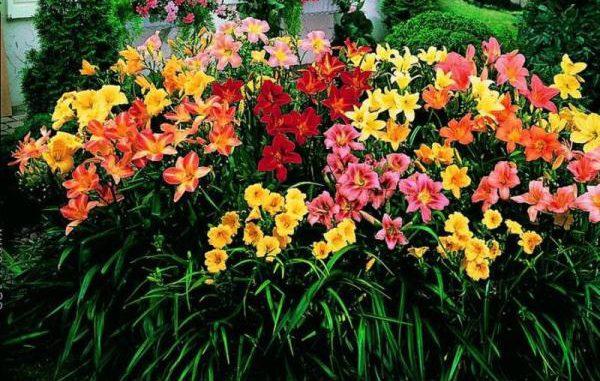
Bestseller
The length of the stems reaches 0.7 meters. The rim size is 140 millimeters. The flower is simple, painted in a lilac-pink tone. The edges of the petals have a greenish-yellow frill. Blooms from the end of the third decade of June to 15 August.
Double River Wye
The daylily is semi-evergreen. The open petals of the buds are 130 millimeters in diameter, like small suns open in the morning, exuding a light aroma. The budding period is from July 25 to the end of August.
Night Beacon
The variety is popular due to the contrasting color of the corolla: dark purple and sunny. The diameter of the opened petals of a simple shape is 80 millimeters.
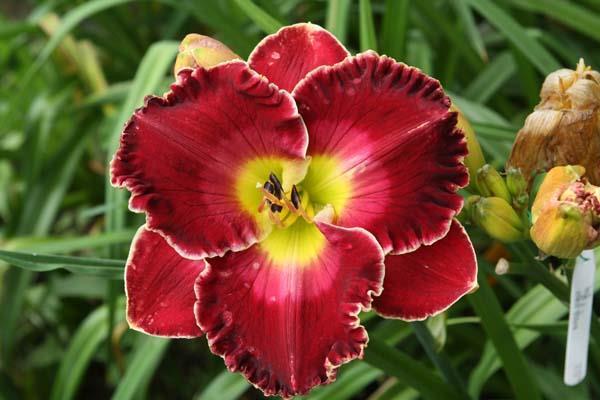
Spotted fever
The daylily rises half a meter above the ground. Terry two-color buds are blooming against the background of lush green foliage. The main background of the outer petals is smoky pink with light coral ripples. The interior is lighter, with dotted coral interspersed.
Black stockings
The variety was bred several years ago. The height of the shoots is up to 0.6 meters. Up to 30 buds bloom on one stem. The diameter of the blossoming corolla is 150 millimeters. Lilac-purple tightly closed petals are framed with a wavy border. Red-yellow stamens peep out of the yellow throat.
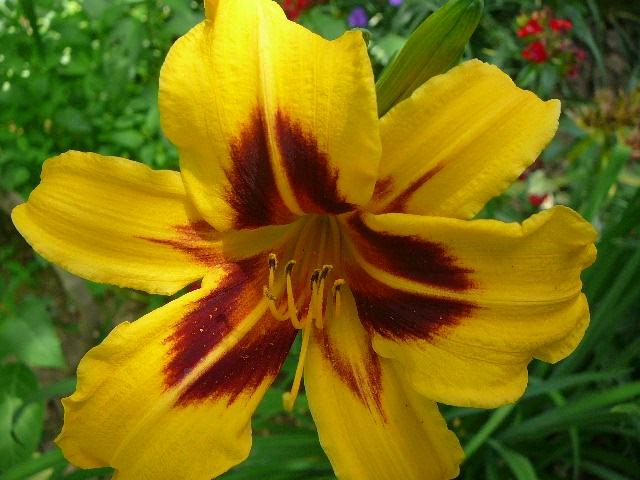
Black prince
The daylily blooms by July 15th. Flowering lasts about 30 days. At the end of the season, buds can be re-set. Peduncles rise up to 1 meter. In the inflorescence, 2 large buds. The petals are narrow, burgundy, with a yellow border in the center. The core is yellow.
Winter-hardy variety: withstands temperatures below 30 degrees. In regions with hot summers, it can be planted in partial shade, with cool ones - in well-lit places.
Stella d'Oro
A dwarf variety that does not raise flower stalks above 0.4 meters. The size of the bud is up to 70 millimeters. Repaired species: blooms intermittently from June to late September. It tolerates planting in flowerpots.
Thin Man
Spyder with huge cascading flowers. The petals are red, with a yellow-green fawn. Flowering time is from July to August. The length of the stems is 1 meter. It tolerates frost well.
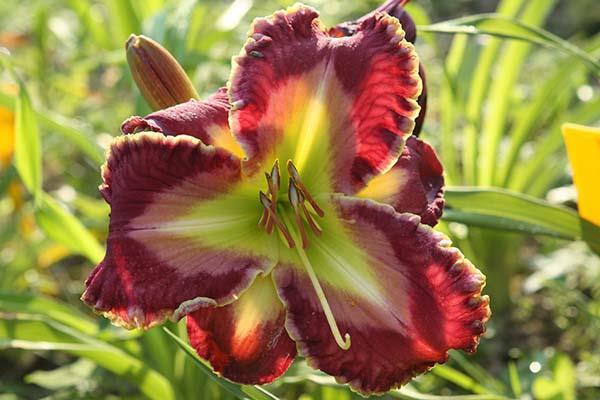
Ginger twist
Daylily of the Spider variety. The diameter of the flower is 28 centimeters. The narrow petals range from orange-yellow to red.
Alpine ruffles
Tetraploid daylily, mid-flowering (end of June). The height of the bush reaches 0.65 meters, the rim span is 140 millimeters. The number of buds on one peduncle during the growing season is 45. The main color is white, the throat is yellow. The flower shape is simple, the edges of the petals are corrugated, yellow. The stamens are yellow, the anthers are black.
Jordan
The profusely blooming daylily blooms in the month of August. Flower size - up to 150 millimeters. The color of the wide, tightly set petals is pink-violet, with lemon throat and stamens. The edges are slightly corrugated.
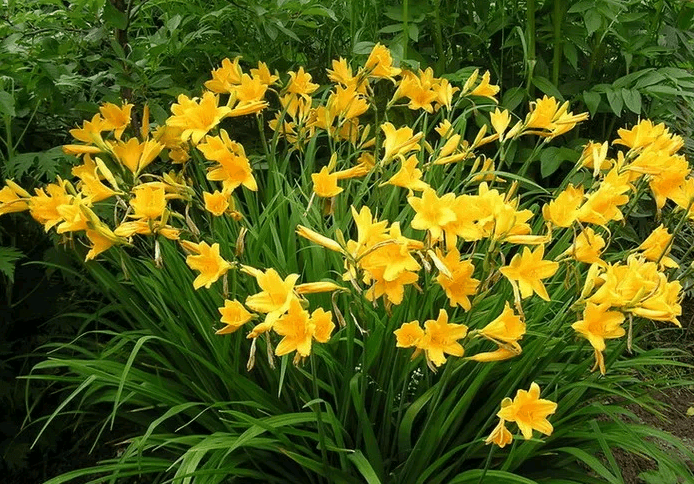
White Hot (white)
Repaired grade. Blooms in late June. The diameter of the flowers reaches 160 millimeters, the height of the peduncles is 0.64 meters. The flower shape is simple, the color is white, with a green-yellow throat. The stamens are yellow.
Born to run (red)
Flower stems rise up to 0.7 meters, have 35 buds branching. Flowering begins in mid-July and repeats in late August. An evergreen variety. The flower shape is simple, the corolla size is 150 millimeters. The color of the petals is dark cherry. The throat is yellow, the border is gold. The stamens are yellow.
Greenway (pink)
A semi-evergreen species of daylily, it grows up to 0.7 meters.Flowers are simple in shape, up to 160 millimeters. The main color is pink, the eye is light pink, the throat and border are green. It dissolves in mid-August.
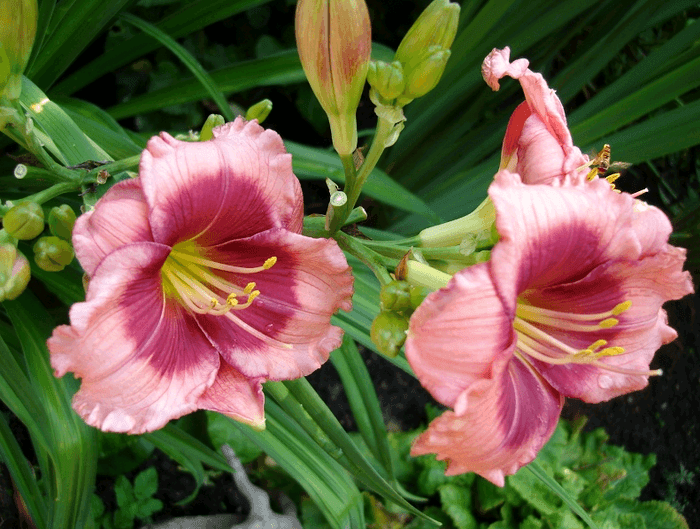
Cultures blooming all summer
Daylilies bloom for 1 day. By the time when the bud opens, there are day, night, long-flowering. In the first case, flowering begins in the morning, by the evening the petals fade. At night, flowers bloom in the afternoon and begin to dry out the next morning. Long-flowering daylilies can bloom at any time and bloom for 16 hours.
A large number of buds on the peduncles gives a long and abundant flowering that decorates the landscape.
At the beginning of blooming, daylilies are divided into categories:
- Very / very / earliest - from the beginning / middle / end of June.
- Medium / medium late - mid / late July.
- Medium / Late / Very - From late July / August / mid September.
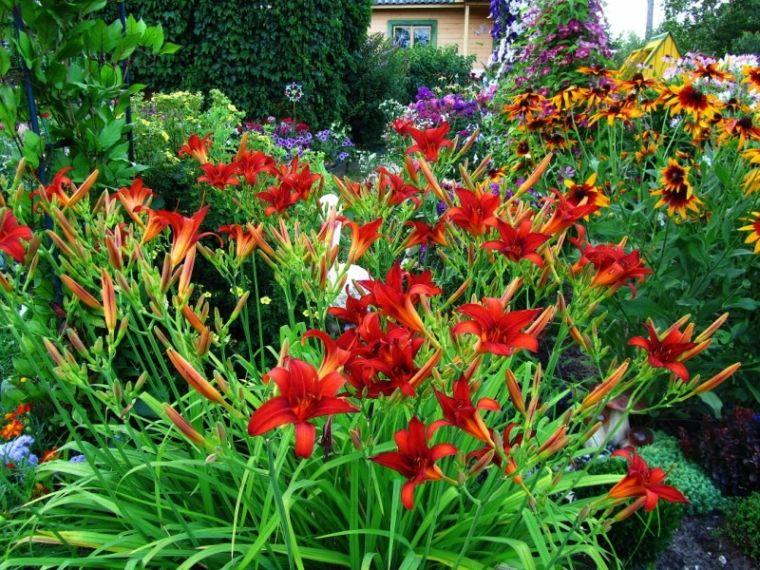
Tetraploid varieties with remontant properties regain color during summer and early autumn.
Daylily hybrids that bloom continuously from early June to late August have not been bred. To create a landscape adorned with bright buds during the summer, remontant plants of different flowering periods are planted. For example, buds are dissolved twice during the growing season:
- Burgundy Love - as very early and mid-late;
- Milred Mitchell - as the earliest and middle late;
- Little Anna Rose - both early and late varieties.
For the manifestation of the qualities of repair, mild weather conditions are required.
The best varieties for Siberia and the Urals
For regions with cold winters, early fall and late spring, dormant / fast-dormant daylilies are the best varieties.

The type of vegetation is distinguished:
- sleeping (DOR);
- evergreen;
- semi-evergreen.
For a more complete characterization of the behavior of daylilies in the autumn-winter period and the possibility of breeding in areas with frosty winters, additional information can be used.
Daylilies are:
- sound asleep;
- half-sleeping;
- gentle evergreen.
Those who sleep soundly shed their foliage after the first frost and resume growth with the establishment of stable heat in the spring.
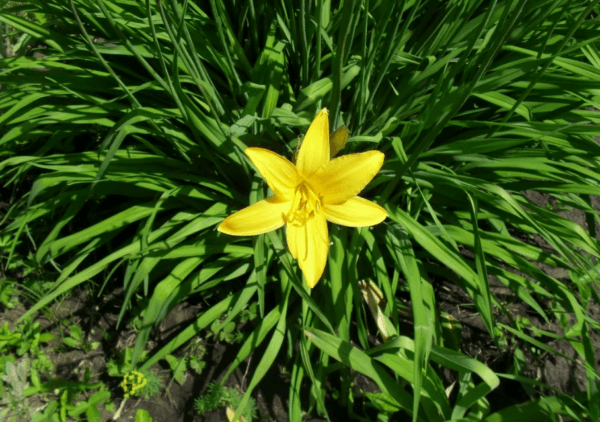
DOR frost-resistant varieties for the Urals and Siberia:
- Sorry mi;
- Frans Hals;
- Enchantted Forest.
Among the dormant varieties, dwarf, undersized plants with beautiful corollas prevail.
What to choose for the Middle Lane
For the gardens of the Middle Lane, semi-sleeping and semi-evergreen daylilies are suitable. Semi-susceptible varieties can withstand prolonged cooling in the autumn, shedding leaves at the beginning of winter. With the onset of the first warm days, they start to grow.
Semi-evergreen daylilies are adapted to vegetation in cold and warm regions.
With the onset of early cold weather, plants lose their leaves, but do not stop growing. In warm areas, they behave like evergreen varieties, remaining leafy. An example of this variety is the Macbeth daylily.
What to choose for the south of Russia
Semi-evergreen and evergreen daylilies will decorate the southern gardens of Russia. Daylily bushes stand in green plumage in winter and summer. A sudden cold snap can cause freezing of the upper sheets and buds. But with the onset of heat, the stems grow from the root buds. Delicate evergreen daylilies do not tolerate frost.
